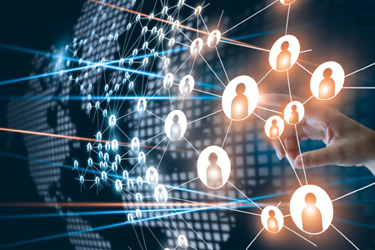The Smart Water Workforce Of The Future
By Sharon Peters

As next-generation technology and personnel arrive on the scene, what does the role of the utility worker look like?
The global water industry is in a time of tremendous change: social, environmental, economic, and technological. As we look back in our history, we can see that we have already experienced several waves of change, and each wave has involved a partnership between people and technology to find new ways to manage our water resources more safely, reliably, and sustainably.
Twenty years ago, in the early days of the automated control of water and wastewater treatment plants and distribution and collection systems, people used to jokingly talk about the future water workforce in terms of the story of the man and the dog. In the story, the man is there to feed the dog, while the dog is assigned to keep the man from touching the equipment and interfering with the perfectly designed and implemented automation strategy. Of course, that’s not how it has worked out in the water industry — at least not yet.
Since that time, some operations have become less attended and there have been many gains in efficiency and effectiveness as a result of implementing new technology. At the same time, systems and equipment have become more complex and integrated. Technology systems bring more and more information to an individual’s desk or work location. Regardless of what job they are doing, interacting with information technology now makes up a significant part of each employee’s workday. Work follows a sort of command center model with information coming in from multiple sources, being used or changed by an individual, and the resulting new information fanning out to multiple destinations inside and outside of the utility to be used in turn for other activities and functions.
This increasing complexity has been challenging for many people to adapt to. We are already in a situation where the complexity regularly goes beyond our human capability to filter and process information, resulting in mistakes and overload. In some cases, utilities have returned to manual processes, are only accessing a fraction of the functional potential of their existing technology systems, or are generating so-called dark data, which is no longer used and may even have been forgotten.
Where Is The Water Industry Today?
Across the globe, communities have urgent needs for water and wastewater infrastructure improvements and safe, reliable, and affordable water and wastewater services. Water and wastewater infrastructure will continue to require a skilled workforce to envision, design, construct, operate, and maintain facilities for the foreseeable future. Resources, especially for public sector organizations, will continue to be constrained and leaders will need to prioritize investments in partnership with their customers and other key stakeholders. Many utilities are already experiencing significant barriers to hiring new water workers and retaining talented employees. There is significant competition from other industries and a corresponding reduction in the number of available candidates who meet the desired educational and related work experience requirements. Rapidly changing technology and escalating retirements are impacting the capacity of the water sector to develop and sustain its future workforce. Something needs to change.
Where Are We Going?
Recent technology innovations are expanding human capabilities across the water industry in three main ways. They are delivering the right information at the right time to help people make more timely, effective, and robust decisions. They are helping people to interact with each other, with customers, with systems and equipment, and with the environment in new and creative ways. Finally, innovations are helping to expand human physical capabilities so that water work can be performed more safely and with less effort. Looking forward, we can expect to see machines continuing to do more and more of the routine, repetitive, and dangerous tasks involved in water work.
The good news is that these developments don’t replace the critical importance of the contribution of people, although they do have the potential to change the roles and activities that people perform. It will be people, not machines, that will be carrying out the creative tasks, training the machines to do what they need to do, explaining how machines and systems work, and sustaining their usefulness by keeping them in good working order. The unique qualities that people bring to the water industry will also be needed to understand the big picture and evolving trends and find new opportunities and potential.
The future water workforce will be valued for unique human qualities such as critical thinking, social intelligence, finding new meaning in data, the ability to understand and connect concepts across multiple disciplines, the ability to filter data and deal with overload, and continuous learning. Unfortunately, if we look at today’s water industry job advertisements and position descriptions, these qualities rarely appear as preferred qualifications.
To improve on the current situation and prepare the water industry for the future, we need to transform our organizations to be — and be seen to be — places that grow and develop the people that work there. We can carry out branding exercises and advertising campaigns and say a lot of things to attract candidates for water industry jobs, but they will not stay in the industry unless we can change together. Water industry organizations need to learn to practice more distributed decision-making, which means making sure employees have more opportunities to make decisions earlier in their career paths and to experience and adapt to the consequences of their decisions. We need to learn to actively practice creativity and reward creative approaches, which can be difficult to achieve in traditionally risk-averse fields. In the past, technology was believed to be the exclusive realm of specialists and beyond the capability of many workers. We need to make sure that, in the future, everyone in our organizations has the opportunity to become familiar with, tinker with, enhance, and use technology to solve problems. As an industry, we need to be open to more flexible job roles. We need to value employees who have deep expertise in particular strength areas, coupled with the ability to communicate and collaborate across many expertise areas to solve problems. We also need to work together more effectively to balance the lessons of experience with creative new ideas.
Imagine the future smart water workforce is made up of people using intelligent water systems of connected new devices and machines designed to deliver role-specific information and enable distributed and seamlessly coordinated decision-making that produces multiple, consistently positive outcomes for customers, communities, and the environment. It may not seem realistic today or tomorrow, but the potential is there for all of us. A few years ago, we wouldn’t have imagined being this close to highways filled with self-driving cars either.
Optimism For The Future
A few years ago, people imagined the mass retirements of the baby boomer generation as a potential disaster for the industry. Now that the retirements are well underway, we are finding it different than we imagined. Under the pressure of necessity, and the reality of the criticality of sustaining 24/7 service, today’s water industry is doing more than we thought we could. New leaders are emerging with new ideas and a passion for innovation and continuous improvement and are less constrained by past practices. Our culture is changing. Let’s all ask ourselves what we can do to help nurture the future smart water workforce.
 Sharon Peters is President and CEO of EMA, Inc., responsible for business strategy and managing EMA’s day-to-day operations. Sharon also works with utilities to build their operations and management capabilities. She helps clients develop organizational and workforce plans to improve quality and reliability, create staffing strategies and employee development programs, and prepare for a more technology and data-driven future. Prior to joining EMA, Sharon worked in operations management and engineering for 11 years with Metro Vancouver, a regional water and wastewater utility serving 2.4 million customers. Sharon is a Registered Professional Engineer and holds an M.Sc. in Civil Engineering and a B.Sc. in Geological Engineering from Queen’s University in Ontario, Canada. She is also a Board member and Executive Director for the Water Customer Care Forum (WCCF).
Sharon Peters is President and CEO of EMA, Inc., responsible for business strategy and managing EMA’s day-to-day operations. Sharon also works with utilities to build their operations and management capabilities. She helps clients develop organizational and workforce plans to improve quality and reliability, create staffing strategies and employee development programs, and prepare for a more technology and data-driven future. Prior to joining EMA, Sharon worked in operations management and engineering for 11 years with Metro Vancouver, a regional water and wastewater utility serving 2.4 million customers. Sharon is a Registered Professional Engineer and holds an M.Sc. in Civil Engineering and a B.Sc. in Geological Engineering from Queen’s University in Ontario, Canada. She is also a Board member and Executive Director for the Water Customer Care Forum (WCCF).
